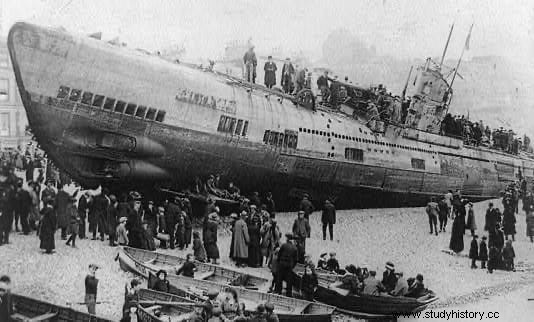Interesting photo, right? Corresponds to the German submarine U-118 washed up on Hastings beach , Sussex (England), after the First World War . Although most of the German fleet was imprisoned in the bay of Scapa Flow, in the Orkney Islands (Scotland), some units were left behind and this was one of them.
It was one of the 329 U-boats that the Imperial Navy launched during the conflict to deal with enemy naval superiority, only the U-118 arrived a little late:built at the AG Vulcan Stettin shipyard in Hamburg (founded in 1851 and still in operation), it entered service on 8 May 1918 and, under the command of Herbert Stohwesser , she was assigned to the submersible flotilla that operated in the Eastern Atlantic . She measured 87 meters long by 7 wide and displaced 1,200 tons.
She was slow to spring into action. Four months no less, until on September 16 of that year she managed to sink the British steam Wellington very close to the Galician coast, at the height of Cabo Villano from A Coruña. On October 2, he scored another victory sinking the tanker Arca off the Irish island of Tory. And there she finished her short active career because Germany requested an armistice the following month, on November 11. The definitive Treaty of Versailles would not be signed until June 28, 1919, but the U-118 did not act again.

In fact, in February 1919 she was handed over to France and soon after she was sent to Scapa Flow she with the sad fate of being scrapped. She however she did not arrive. On April 15, during a storm, the cable broke with which she was towed and drifted, running aground at noon on the aforementioned English beach of Hastings to the astonishment of all the locals. All attempts to get him out of there were useless :Neither the tractors that tried to push her back into the water nor the shots from a French destroyer that was ordered to destroy her, given the previous failure, made a dent in the submarine.
As there were no options left, since blowing it up with dynamite was ruled out as the town was very close and especially a hotel full of tourists, for a couple of weeks the U-118 carried out a new mission, unimaginable months ago:to become a tourist attraction . Thousands of people came to see it and the City Council began to charge an entrance fee for allowing her to come on deck, money that was intended to finance the return of British soldiers from the front.
But then something unexpected happened. The two coastguards responsible for showing the interior of the ship to the curious got sick suddenly and simultaneously, her condition progressively worsening to the point that both died soon. The exact cause was never known; there was talk of thedecomposition of food on board and the release of chlorine gaseous from worn out batteries.

This forced to prohibit boarding the ship and the most that could be done from then on was to be photographed with him. Finally, the U-118 fulfilled her destiny and ended scrapped in situ at the end of 1919, leaving behind some elements:the deck gun (150 mm), for example, remained on the beach for another couple of years and from time to time loose pieces appeared in the sand. A gun found by the village children when they first entered its interior still hangs on the wall of a local pub.
The coast of Hastings must have something because, incredible as it may seem, in 1921 the events were repeated when another German submersible, the UB-131, ran aground very close (in Bulverhythe). . She was smaller and had never sunk a ship. There are also no details or photos of what happened to him.
